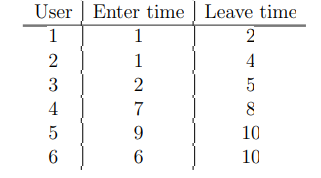Algorithm design with sorting. Each of n users spends some time on a social media site. For each i = 1, . . . , n, user i enters the site at time ai and leaves at time bi ≥ ai. You are interested in the question: how many distinct pairs of users are ever on the site at the same time? (Here, the pair (i, j) is the same as the pair (j, i)). Example: Suppose there are 5 users with the following entering and leaving times: Then, the number of distinct pairs of users who are on the site at the same time is five: these pairs are (1, 2), (1, 3), (2, 3), (4, 6), (5, 6). (Drawing the intervals on a number line may make this easier to see). (a) Given input (a1 , b1),(a2 , b2), . . . ,(an, bn) as above in no particular order (i.e., not sorted in any way), describe a straightforward algorithm that takes Θ(n2)-time to compute the number of pairs of users who are ever on the site at the same time, and explain why it takes Θ(n2)-time. [We are expecting pseudocode and a brief justification for its runtime.] (b) Give an Θ(n log(n))-time algorithm to do the same task and analyze its running time. (Hint: consider sorting relevant events by time). [We are expecting pseudocode and a brief justification for its runtime.]
Example: Suppose there are 5 users with the following entering and leaving times:
Then, the number of distinct pairs of users who are on the site at the same time is five: these pairs are (1, 2), (1, 3), (2, 3), (4, 6), (5, 6). (Drawing the intervals on a number line may make this easier to see).
(a) Given input (a1 , b1),(a2 , b2), . . . ,(an, bn) as above in no particular order (i.e., not sorted in any way), describe a straightforward algorithm that takes Θ(n2)-time to compute the number of pairs of users who are ever on the site at the same time, and explain why it takes Θ(n2)-time. [We are expecting pseudocode and a brief justification for its runtime.]
(b) Give an Θ(n log(n))-time algorithm to do the same task and analyze its running time. (Hint: consider sorting relevant events by time). [We are expecting pseudocode and a brief justification for its runtime.]

Trending now
This is a popular solution!
Step by step
Solved in 3 steps







